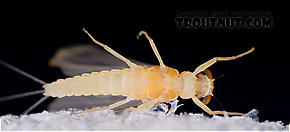Blog & Latest Updates
Fly Fishing Articles
Insects by Common Name


> > Small Sulphurs
The Specimen
The Discussion
| GONZO | October 28th, 2008, 3:52 pm | |
Site Editor "Bear Swamp," PAPosts: 1681 | It's been my suspicion for quite some time that a good part of the credit given to dorothea for creating the later, lighter-colored "little sulphur" hatch should probably go to the same species (or species complex) that creates the earlier, larger, darker hatch--E. invaria. Many anglers who fish the small suphurs on valley limestone streams in my home state believe (or have been led to believe) that they are fishing the dorothea hatch. Close inspection of the mayfly that causes the activity usually doesn't bear that out. Most of the true dorothea hatches seem to come from mountainous areas where the streams are faster and have rockier bottoms. All of the specimens in this section are from PA, and this seems to provide a good case in point. This specimen and the nymph (#766) are good examples of dorothea, and they both came from sections of the Brodheads in the Poconos. The other specimens came from big limestoners and appear to be invaria. Notice that all of the dun and spinner specimens, except for this one, have banded tails (dark markings at the segments). As far as I know, this is not characteristic of the Eastern version of dorothea (E. dorothea dorothea), but it is a trait of invaria. | |
| Troutnut | October 29th, 2008, 4:01 pm | |
Administrator Bellevue, WAPosts: 2737 | Thanks. That makes a lot of sense. | |
| Jason Neuswanger, Ph.D. Troutnut and salmonid ecologist | ||
| TightLine | July 22nd, 2014, 9:39 am | |
| Missouri Posts: 1 | We have these little guys in our spring creeks here in Missouri. They are usually about a size 24. Duns are White/opaque in color with the big orange eyes. The hatch is in the evening from May to October with the prime months June to September. A challenging fly to fish with precise presentations necessary. | |
| McCloud Redband | ||
| Entoman | July 22nd, 2014, 7:28 pm | |
| Northern CA & ID Posts: 2604 | Welcome to the forum, Tightline. While anything is possible, your tiny flies are probably in one of the baetid genera of Little Sulfur Quills. True PMD's are much larger (14 to 18). If you look closely, you may notice they only have two tails and are either lacking hind wings or they are virtually impossible to make out with eyes older than 35. ;) | |
| "It's not that I find fishing so important, it's just that I find all other endeavors of Man equally unimportant... And not nearly as much fun!" Robert Traver, Anatomy of a Fisherman | ||
Quick Reply
You have to be logged in to post on the forum. It's this easy:
Related Discussions
| Title | Replies | Last Reply |
| Re: Little J In General Discussion by Wbranch | 3 | May 17, 2009 by GONZO |
| Re: Invaria - Dorothea confusion In the Mayfly Genus Ephemerella by Entoman | 17 | Feb 7, 2012 by Entoman |
| Re: Anyone know more about Ephemerella septentrionalis? In the Mayfly Species Penelomax septentrionalis by Troutnut | 11 | Jul 18, 2011 by Oldredbarn |
| Ephemerella dorothea dorothea (PED) In the Identify This! Board by Wiflyfisher | 0 | |
| Re: An important hatch In the Mayfly Species Baetisca laurentina by Troutnut | 2 | Apr 8, 2013 by Willy |
| Re: stupid question In Male Baetis bicaudatus Mayfly Nymph by Brian314 | 2 | Feb 27, 2022 by Brian314 |
| Re: So is Ep Infrequens now known as Ep Dorothea? In the Mayfly Species Ephemerella dorothea infrequens by Wbranch | 20 | Jul 1, 2014 by Crepuscular |
| Re: Male or female? In General Discussion by Shawnny3 | 8 | Apr 9, 2009 by GONZO |
| Re: A Cinygmula nymph without protruding mouthparts? In Cinygmula Mayfly Nymph by Troutnut | 12 | Mar 28, 2013 by Brookyman |
| Re: Thoughts In Male Eurylophella Mayfly Spinner by Taxon | 5 | Mar 7, 2013 by Entoman |
Troutnut.com is copyright © 2004-2024 Jason
Neuswanger (email Jason). See my FAQ for information about use of my images.
 privacy policy
privacy policy



